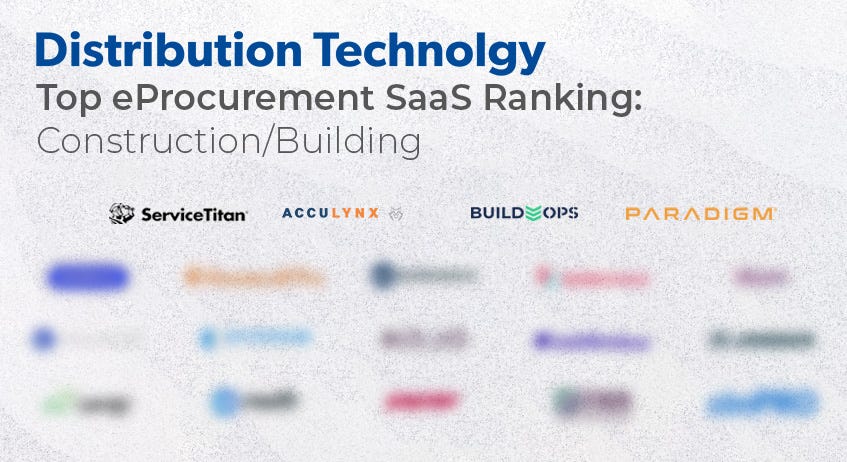eProcurement Top Rankings: Building Materials and Construction
Construction🏗, Food🍅 and Auto Parts🚗 are seeing big adoption.
In our 2023 B2B outlook, we’ve predicted that we’ll witness the eProcurement 2.0 phenomenon accelerate in multiple verticals of B2B Distribution by year end. Never one to let a good prediction go to waste, this week we take a look at what we consider to be the most developed B2B vertical in eProcurement with a focus on building materials and construction - then, in an upcoming newsletter, we’ll cover our runner ups in food and auto parts. For those operating in other verticals, you’ll find a wealth of insight as this trend is not contained to these 3 industries; instead, it’s manifesting itself across the spectrum of wholesale distribution.
We’ll be highlighting the top tech players, their fundraising, their scale and volumes, business models, notable partnerships with distributors - retailers - or suppliers and the gaps that distributors need to overcome to better take advantage of these opportunities.
What is eProcurement 2.0?
SaaS (software-as-a-service) tech companies provide their software product to SMBs (small-medium businesses) to help those companies operate, sell to customers, dispatch jobs, manage employees and now - procure suppliers. You can think of these SaaS tools as the modern-day ERP for a SMB. However, SMBs don’t need ERPs - that would be overkill and way too expensive. Over the past 20 years, these SaaS tools have been penetrating the SMB market and now, the SaaS tools are realizing they can make a lot of money, and solve legitimate pain for their customers, by helping those customers seamlessly procure their supplies.
eProcurement 1.0, by comparison, is SAP Ariba, Coupa and other ERP-powered procurement tools made for large enterprises. Generally, these tools help the enterprise procure non-essential spend, but - in some cases - they also help procure more mission critical inventories. eProcurement 1.0 has been extremely horizontal and focused on helping enterprises operating across a myriad of different verticals. eProcurement 2.0 is the opposite and vertical-specific, by nature of a SaaS tool solving specific problems for SMB customers operating in a given industry.
What’s Their Business Models?
Up until eProcurement, SaaS tools charge the customer a monthly or yearly subscription. There could be a base plan, premium and enterprise plan - but, you get the idea - you pay a relatively nominal fee, and you receive the benefit of the software.
Beyond SaaS fees, eProcurement opens up a multitude of new ways for SaaS companies to monetize the volumes of materials and transactions.
ServiceTitan, for example, has publicly stated that it’s processing $20 Billion in payments. One should assume that some portion of the $20B is credit-card payments. Those volumes are quite lucrative and ServiceTitan can receive healthy referral fees on that portion of payment processing. My guess is they probably earn $15-25mm in profit from $20B in payment processing volumes.
Acculynx, however, is charging take-rates. The most highly coveted form of monetization for a tech company yet simultaneously the most infuriating fee for a distributor to pay. Charging a take rate on distribution is one of the best expressions of power and leverage by a tech company. They have so much lock-in with the customer that they can levy a fee on the transaction. This is a great example of how important these SaaS tools are to the SMB customer. These customers use the SaaS tool to operate their entire business. And, the distributor will do everything in their power to NOT pay a take-rate. Yet, still, the customer puts pressure on the distributor because it makes the customer’s life easier and more seamless. Keep in mind, charging a take-rate makes you public enemy #1 in the eyes of the distributor. It is easily the most contentious mechanism to extract value from transaction volumes.
Who Are The Customers? Builders & General Contractors vs. Trade Contractors 🏗
In construction specifically, there are a myriad of different stakeholders with unique needs. We’ve seen SaaS tools rise to the challenge and that’s why you see a slew of different tools in the market. General contractors and builders have their own set of needs - Hyphen - is one example of a contractor SaaS tool focused on that part of the market.
Sub-contractors, also called trade contractors, have a variety of tools to choose from which tend to focus on different types of trades. Roofing contractors have more specialized needs so you see a number of roofing contractor-specific tools like Acculynx, JobNimbus, and Roofr. Electricians, HVAC and plumbers tend to have similar workflows and you see a number of tools focus on the collective interests of those trades.
You also have a bifurcation between how big the trade contractor is. Kojo is more geared towards commercial contractors which are larger and have multiple crews. Whereas, ServiceTitan and HouseCall Pro are focused on smaller, more residential contractors. These are just a few of the dynamics when thinking about which tool is catering to which audience of contractor customers.
What Can Distribution Do?
This new wave of software tools creates a big opportunity for distributors to capitalize on these fast-growing demand channels to gain market share with new customers and share of wallet with existing customers. Additionally, we've seen a very high level of customer stickiness for distributors in these new digital demand channels, creating opportunity for higher margins.
That said, just being connected to these SaaS tools isn't enough. Do you have high quality data that you can send to your customers? If you’re connected, but you don’t have good data – the connection does no good. If anything, it might hurt you as you could drive customers away with a bad experience. However, with the right strategy and capabilities, being first or early to these new channels gives a distributor a significant competitive advantage against late movers.





